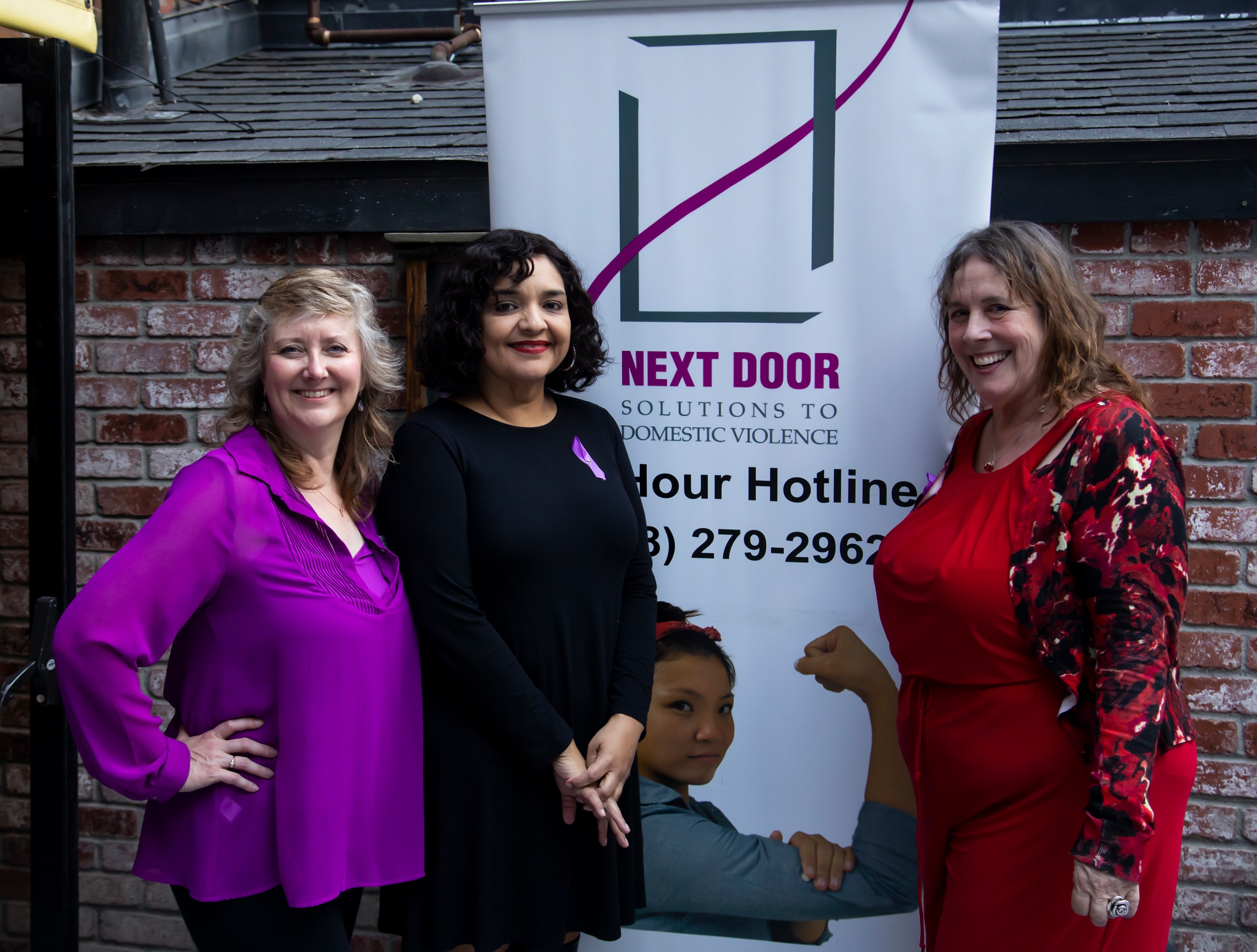
In conversation with Next Door Solutions to Domestic Violence
Over the past year, shelter-in-place orders and the economic effects of the pandemic led to spikes in intimate partner violence. We sat down with Beth Williams at Next Door Solutions to Domestic Violence to talk about their work, how their clients have coped over the past year, and what lies ahead for them.
Photo: Beth Williams, Development Director at Next Door Solutions to Domestic Violence (left), Esther Peralez-Dieckmann, Executive Director (center) and a survivor/former board member (right).
What does Next Door do?
Our mission is to end domestic violence by creating paths for survivors from crisis to safety, stability, and self-sufficiency. The organization was launched in 1971 by a group of women who volunteered to start a hotline for victims of domestic violence to find resources. At that time, domestic violence wasn’t even considered a crime yet—as hard as that is to imagine.
This year marks our 50th anniversary. We’re still using the same hotline number, but it’s now managed 24/7 by trained staff. We’ve also added a number of services including shelter and housing services, community and systems advocacy, crisis intervention counseling, legal advocacy, therapy, case management, and support groups (including groups for Spanish speakers, men, teens, and LGBTQIP people).
How did you find ways to engage with your clients this past year when so many were trapped at home due to shelter-in-place mandates, job loss, or school closures?
Like many, we moved all our programming virtually. That enabled us to keep an open line of communication with clients who were already engaged with us. We were actually surprised by the participation we saw in these virtual formats, including from men who typically did not attend our in-person sessions as often as women.
On the other hand, we had to rethink how people could reach out to us in crisis situations, and the solution came from clients themselves. While we saw the number of calls dramatically drop when shelter-in-place was announced and victims were trapped with their abusers, outreach to us via social media skyrocketed. Many victims were fearful of being heard if they called, but found that direct messaging us on social media drew less attention from their abusers. We also saw more activity on the Safe Chat Silicon Valley platform, which is a confidential online chatting platform that connects people experiencing domestic violence with an advocate, managed in partnership with other providers in Santa Clara. This really enabled us to keep communication lines open.
What were some of the new needs you found yourself addressing during this time?
We’ve always been responsive to our clients’ needs, but the scale and breadth this past year were absolutely unprecedented. In the beginning of the pandemic, when most food pantries hadn’t set up large-scale distribution yet, many of our clients came to us for food. They had either lost their jobs, or their children weren’t getting meals through school anymore, and really needed support. We tapped into our unrestricted funds to provide food.
We also ramped up our cash assistance, going from distributing $30,000 annually to $1 million last year. This went to cover things like rental assistance and utility bills, which we were doing before, but also a whole new set of needs like childcare costs during distance learning for parents who had to work, and the internet and devices needed for children to participate in school remotely, and more.
We also started offering therapy in January 2021. The needs are huge. We actually have a waitlist because we can’t accommodate everyone. People have experienced a lot of trauma, having sheltered in place with their abusers. We’re also seeing the impact on children who have been exposed to a lot of violence and stress during this time, and we anticipate we’ll have to double down on these types of services in the months and years to come.
How did you adapt your housing programs to meet health guidelines?
To comply with health guidelines related to COVID-19, we had to rely more heavily on our hotel program. These are vetted hotels we have contracts with year-round to provide rooms for overflow, along with agreements related to safety, confidentiality, and communication. This was absolutely essential, and enabled us to not turn anyone away, as well as observe quarantine protocols for new clients before they moved into our shelter. We could not have done it without these partners.
How has the current economic situation impacted your clients ability to get back on their feet?
Before the pandemic, clients would usually stay two weeks in our shelter. Now, it’s closer to a month, or two months in some cases. We also see this in the two transitional housing sites we operate in San Jose and Santa Clara, where people are staying longer and longer. The shortage of affordable housing in Silicon Valley was always a challenge, but has now become a huge bottleneck. As the job market has contracted, it’s become much more difficult for our clients who are leaving their place of abuse to find employment and stable housing.
What’s the most pressing need you’re seeing in your work today?
The main difficulty is that all the different barriers and challenges that a victim of violence faces are connected and need to be addressed at the same time: economic security, employment, housing, education equity... Essential needs are still very much top of mind for many of our clients (cash assistance, food, childcare), but what is essential in the long run is for them to find employment and stable housing, and build self-sufficiency. We’re currently hiring bilingual employment specialists and housing advocates to help them prepare for interviews, put together a resume, and find stable housing. It’s a challenging time, and we know that survivors don’t always have all the resources they need, so we anticipate it will be a long road to recovery for many of them.
What are some of the changes you made this year to your programming that you think will stick after the pandemic?
Right now, we have 16 support groups throughout Santa Clara County. Having these groups convene in a virtual format has actually enabled us to see higher participation, as well as open up new ones like the LGBTQIP group and teen group we launched this year. We are exploring ways we can maintain a hybrid engagement model, which many clients seem to prefer.
The spotlight that was put on children this past year—in particular children’s mental health—has also led us to consider investing more in this space. This is actually a request from many of our clients who are seeing their children struggle. A lot of the kids have never had healthy relationships modelled for them. There are also going to be very long lasting effects for these children who have been so exposed to violence in the past year and a number of additional stressors, like financial and housing insecurity.
What inspires you in your work in the community?
The survivors and their children are inspiring with their resilience and ability and desire to recover and become self-sufficient. My hope is that we can show up as a community and support them in building a better future for themselves.

